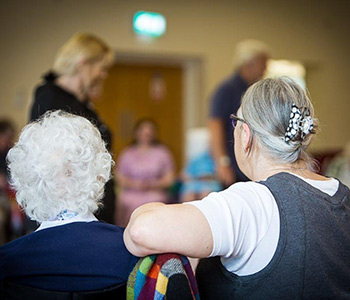On Tuesday evening I was running a session on Communication and Behaviour with a Support 4 Memory group. I always include some material from Prof. Steven Sabat when I’m talking about this subject. The next day, I thought I’d see if he’s published anything else recently, since the webinar some of us attended in October last year.
I first came across Sabat through Dementia Alliance International. This is the global association run by people with dementia for people with dementia. They tend to be critical about the traditional biomedical way of looking at dementia and I was intrigued that this man who is an Emeritus Professor of Neuropsychology should be regarded by them as a friend and supporter. But when I started to read things, he has written I began to see why. A bonus for me is that he acknowledges and builds on the work of Tom Kitwood, with whom, as you know, I worked for a year. Kiitwood coined the term “Malignant Psychology” to describe the way that people with dementia are often treated by those around them. His work was based largely on people living in residential care homes. Care workers, he said, are not deliberately being unkind – in fact they are trying to help. The difficulty is that they have so many physical tasks to complete that they think that is the most important part of their job. He called this the “task centred” approach. These workers had not been made aware that to understand and respond to the unique identity of the person is actually essential if the people in their care are to thrive.
Kiitwood died in 1998 and since then many people have built on his work. Some have been applying the same principles to people living at home with care partners.
This is difficult country to navigate. In a community like Tibbs Dementia, it is a skill we have to learn and keep relearning. How do we help people with dementia and their care partners equally? This dilemma was thrown into sharp relief for us by the recent visits of Wendy Mitchell -both of them. (When writing this I checked and found that Wendy Mitchell is a member of Dementia Alliance International and writes a regular blog with news from the UK.) Most people who heard her at our Team Day attended by staff and volunteers were blown away by her. People felt so inspired by her “Can do” approach and an awful lot of us have purchased her book – “Somebody I used to know”. But she also spoke to our Young Onset group which is attended by care partners as well as people with dementia. There was significant pushback afterwards, I gather, by some carers who were disturbed by what she had to say. They felt that they had been doing it wrong and their sense of guilt and inadequacy was made worse than it already was. This is absolutely not what we want to happen.
What can we do? How can we help to hold these two different realities together in the same safe space within our community?
With this mulling around in my mind I discovered a scholarly article by Steven Sabat which I think might be helpful. In this outline he uses four different possible ways of looking in order to understand the behaviour of a person with dementia.
- Says that the person’s behaviour can always be explained by the physical damage to the brain caused by dementia. The person is seen completely through the lens of the disease, and we measure the things which they can’t do rather than those they can. This is the traditional biomedical model.
- We might also ask ourselves how the person is reacting to the damage to their brain? How would they have reacted to a major threat disturbing life event before they had dementia? (psycho/social model)
- Another factor is the way that the person is being treated by other people who are supporting them. That may be friends and family as well as professionals. (psycho/social model)
- The final factor is the reaction of the person with dementia to being treated the way they are. Do they withdraw or do they react with anger? (psychological)
Article by Sabat “A bio-psycho-social approach to dementia. (2008) (www.researchgate.net).
Sabat suggests that all four of these different ways of understanding people are needed and he is arguing for a Bio/Psycho/Social approach.
He says that we see what we expect to see. We have all been conditioned to see dementia as a defect and so that’s what we see – and we respond appropriately. So, if we expect to see things that aren’t going well, that’s what we’ll see. Is the anxiety we see in the person a symptom of dementia or a response to something that has happened to them for example?
He feels very strongly that we need to keep reminding ourselves that no two people are alike. People with the same type of dementia and the same degree of severity doesn’t mean they will behave the same. There is no such thing as ONE SIZE FITS ALL.
I wonder if it would help us to support care partners by using the same approach, suggested by Sabat, and asking those questions?
- Is the care partner seen through the lens of age, underlying health conditions, weariness, depression? Are assumptions made about what they can and can’t do?
- How are they reacting to the dementia of the person they are supporting? How do they usually react to situations which make enormous physical and emotional demands on them? The loss of control, the unpredictability, the inability to ‘make it better’? Could they have experienced anything like this before?
- How are they being treated by other people? The same as they were before? Do people avoid them? Do other people understand? How is the family reacting?
- How does the carer react to being treated like this? Do they withdraw or do they react with anger?
I think this kind of works. Personally, I can’t wait till we can get back to meeting face to face so that we can start the Encompass groups again for care partners on their own and Clear Voices similarly. It is really important that everyone has a voice and is listened to. Each group needs their own safe space. Zoom has kept us together so, but we need more, don’t we?




